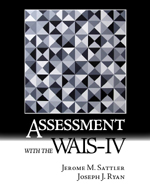|
JEROME M. SATTLER, PUBLISHER, INC. |
|||
| Reviewers' Comments |
PREFACE
Assessment with the WAIS–IV is designed as both a teaching text and a reference source for students and professionals. The text provides an in-depth analysis of a major instrument useful for the cognitive assessment of older adolescents and adults. Some notable features of the text include the following: 1. A chapter covering general guidelines for administering tests 2. A thorough discussion of the psychometric properties of the WAIS–IV 3. An in-depth presentation of each WAIS–IV
subtest, including a description, 4. The reliability, validity, and estimated Full
Scale IQs associated with over 70 5. Guidelines for interpreting the four individual
WAIS–IV scales and the 6. Tables for comparing the WAIS–IV General
Ability Index (GAI) with the 7. Forms for administering Coding—Incidental Learning and Coding—Copy 8. A form for recording psychological and physical
difficulties observed during test 9. Instructions for administering the subtests on
the Perceptual Reasoning Scale 10. Guidelines for using an interpreter 11. A chapter covering aging and cognitive
ability, including a description of the 12. Appendixes with confidence intervals,
guidelines for interpreting WAIS–IV This edition contains several learning aids. These include
Edwin G. Boring said, “Intelligence is whatever intelligence tests measure.” Although this comment may have been facetious, it strikes a chord in the text authors. We wonder, Does the revised structure of the WAIS–IV gives a more valid picture of the nature of intelligence than the former edition? The new edition will, of course, need to be investigated more extensively before a final judgment can be made about its value as a cognitive assessment instrument. Our field needs to study, in particular, how the three subtests new to this edition (Visual Puzzles, Figure Weights, and Cancellation) contribute to our understanding of the cognitive functioning of both older adolescents and adults. Note to instructors: An Instructor’s Manual with multiple-choice questions, written by Jerome M. Sattler and Joseph J. Ryan, accompanies Assessment with the WAIS–IV. PowerPoint™ presentations highlighting the main points of each chapter are also available, prepared by Gina T. Mercer, Joseph J. Ryan, and Jerome M. Sattler.
|

